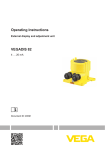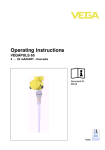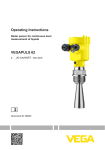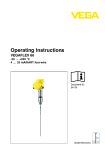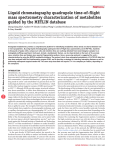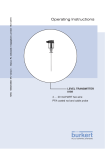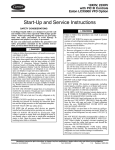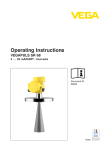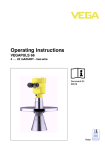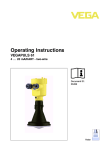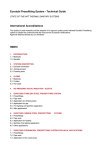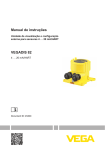Download Operating Instructions - VEGADIS 82 - 4 … 20 mA/HART
Transcript
Operating Instructions External display and adjustment unit for 4 … 20 mA/HART sensors VEGADIS 82 4 … 20 mA/HART Document ID: 45300 Contents Contents 1 About this document 1.1Function............................................................................................................................ 4 1.2 Target group...................................................................................................................... 4 1.3 Symbols used................................................................................................................... 4 2 For your safety 2.1 Authorised personnel........................................................................................................ 5 2.2 Appropriate use................................................................................................................. 5 2.3 Warning about incorrect use.............................................................................................. 5 2.4 General safety instructions................................................................................................ 5 2.5 CE conformity.................................................................................................................... 5 2.6 NAMUR recommendations............................................................................................... 6 2.7 Environmental instructions................................................................................................ 6 3 Product description 3.1 Configuration..................................................................................................................... 7 3.2 Principle of operation........................................................................................................ 8 3.3 Packaging, transport and storage.................................................................................... 10 3.4 Accessories and replacement parts................................................................................ 10 4Mounting 4.1 General instructions........................................................................................................ 12 4.2 Mounting instructions...................................................................................................... 12 5 Connecting to power supply 5.1 Preparing the connection................................................................................................ 15 5.2 Connection technology and steps................................................................................... 16 5.3 Wiring plan...................................................................................................................... 17 5.4 Connection HART standard............................................................................................ 17 5.5 Connection HART multidrop........................................................................................... 18 5.6 Connection signal conditioning instrument...................................................................... 18 5.7 Connection example....................................................................................................... 20 5.8 Switch-on phase............................................................................................................. 20 6 Set up with the display and adjustment module 6.1 Short description............................................................................................................. 21 6.2 Insert display and adjustment module............................................................................. 21 6.3 Adjustment system.......................................................................................................... 22 6.4 Measured value indication - Selection national language................................................ 23 6.5 Start menu....................................................................................................................... 23 6.6 Parameter adjustment - VEGADIS 82.............................................................................. 24 6.7 Parameter adjustment VEGAPULS WL 61...................................................................... 28 6.8 Parameter adjustment VEGAWELL 52............................................................................ 40 6.9 Parameter adjustment - Sensors from other manufacturers via Generic HART............... 44 8 Diagnostics and service 8.1Maintenance................................................................................................................... 50 2 VEGADIS 82 • 4 … 20 mA/HART 45300-EN-140506 7 Setup instrument and sensor with PACTware 7.1 Connect the PC............................................................................................................... 47 7.2 Parameter adjustment..................................................................................................... 48 7.3 Saving the parameter adjustment data............................................................................ 49 Contents 8.2 8.3 8.4 8.5 8.6 Asset Management function............................................................................................ 50 Rectify faults.................................................................................................................... 51 Exchanging the electronics module................................................................................. 52 Software update.............................................................................................................. 52 How to proceed if a repair is needed............................................................................... 53 9Dismounting 9.1 Dismounting steps.......................................................................................................... 54 9.2Disposal.......................................................................................................................... 54 45300-EN-140506 10Supplement 10.1 Technical data................................................................................................................. 55 10.2 HART communication..................................................................................................... 58 10.3Dimensions..................................................................................................................... 58 Safety instructions for Ex areas Please note the Ex-specific safety information for installation and operation in Ex areas. These safety instructions are part of the operating instructions manual and come with the Ex-approved instruments. Editing status: 2014-04-16 VEGADIS 82 • 4 … 20 mA/HART 3 1 About this document 1 About this document 1.1Function This operating instructions manual provides all the information you need for mounting, connection and setup as well as important instructions for maintenance and fault rectification. Please read this information before putting the instrument into operation and keep this manual accessible in the immediate vicinity of the device. 1.2 Target group This operating instructions manual is directed to trained specialist personnel. The contents of this manual should be made available to these personnel and put into practice by them. 1.3 Symbols used Information, tip, note This symbol indicates helpful additional information. Caution: If this warning is ignored, faults or malfunctions can result. Warning: If this warning is ignored, injury to persons and/or serious damage to the instrument can result. Danger: If this warning is ignored, serious injury to persons and/or destruction of the instrument can result. • → 1 Ex applications This symbol indicates special instructions for Ex applications. List The dot set in front indicates a list with no implied sequence. Action This arrow indicates a single action. Sequence of actions Numbers set in front indicate successive steps in a procedure. Battery disposal This symbol indicates special information about the disposal of batteries and accumulators. 45300-EN-140506 4 VEGADIS 82 • 4 … 20 mA/HART 2 For your safety 2 For your safety 2.1 Authorised personnel All operations described in this operating instructions manual must be carried out only by trained specialist personnel authorised by the plant operator. During work on and with the device the required personal protective equipment must always be worn. 2.2 Appropriate use The VEGADIS 82 is suitable for measured value indication and adjustment of 4 … 20 mA/HART sensors. You can find detailed information about the area of application in chapter "Product description". Operational reliability is ensured only if the instrument is properly used according to the specifications in the operating instructions manual as well as possible supplementary instructions. 2.3 Warning about incorrect use Inappropriate or incorrect use of the instrument can give rise to application-specific hazards, e.g. vessel overfill or damage to system components through incorrect mounting or adjustment. 2.4 General safety instructions This is a state-of-the-art instrument complying with all prevailing regulations and guidelines. The instrument must only be operated in a technically flawless and reliable condition. The operator is responsible for the trouble-free operation of the instrument. During the entire duration of use, the user is obliged to determine the compliance of the necessary occupational safety measures with the current valid rules and regulations and also take note of new regulations. The safety instructions in this operating instructions manual, the national installation standards as well as the valid safety regulations and accident prevention rules must be observed by the user. For safety and warranty reasons, any invasive work on the device beyond that described in the operating instructions manual may be carried out only by personnel authorised by the manufacturer. Arbitrary conversions or modifications are explicitly forbidden. 45300-EN-140506 The safety approval markings and safety tips on the device must also be observed. 2.5 CE conformity The device fulfills the legal requirements of the applicable EC guidelines. By affixing the CE marking, we confirm successful testing of the product. VEGADIS 82 • 4 … 20 mA/HART 5 2 For your safety You can find the conformity certificate in the download section under www.vega.com. 2.6 NAMUR recommendations NAMUR is the automation technology user association in the process industry in Germany. The published NAMUR recommendations are accepted as the standard in field instrumentation. The device fulfills the requirements of the following NAMUR recommendations: • NE 53 – Compatibility of field devices and display/adjustment components For further information see www.namur.de. 2.7 Environmental instructions Protection of the environment is one of our most important duties. That is why we have introduced an environment management system with the goal of continuously improving company environmental protection. The environment management system is certified according to DIN EN ISO 14001. Please help us fulfill this obligation by observing the environmental instructions in this manual: • • Chapter "Packaging, transport and storage" Chapter "Disposal" 45300-EN-140506 6 VEGADIS 82 • 4 … 20 mA/HART 3 Product description 3 Product description Type label 3.1 Configuration The type label on the housing contains the most important data for identification and use of the instrument: 1 2 3 4 5 6 7 12 11 10 9 8 Fig. 1: Layout of the type label (example) 1 Instrument type 2 Product code 3 Field for approvals 4 Electronics/Voltage supply 5 Protection rating 6 Hardware/software version 7 Order number 8 Serial number of the instrument 9 Data-Matrix-Code for Smartphone-App 10 Reminder to observe the instrument documentation 11 Device protection class 12 ID numbers, instrument documentation Serial number - Instrument search The type label contains the serial number of the instrument. With it you can find the following instrument data on our homepage: • • • • Article number (HTML) Delivery date (HTML) Order-specific instrument features (HTML) Operating instructions at the time of shipment (PDF) Go to www.vega.com, "VEGA Tools" and "Instrument search". Enter the serial number. As an alternative, you can access these data via your smartphone: • • • 45300-EN-140506 Instrument versions Download the smartphone app "VEGA Tools" from the "Apple App Store" or the "Google Play Store" Scan the Data Matrix code on the type label of the instrument or Enter the serial number manually in the app The VEGADIS 82 is available in different housing materials, see chapter "Technical data". The instrument is optionally available with or without display and adjustment module. Scope of this operating instructions manual This operating instructions manual applies to the following instrument versions: • Software from 1.0.0 VEGADIS 82 • 4 … 20 mA/HART 7 3 Product description • Scope of delivery Hardware from 1.0.0 The scope of delivery encompasses: • • • Display and adjustment unit Mounting accessories (optional) Documentation –– this operating instructions manual –– Ex-specific "Safety instructions" (with Ex versions) –– if necessary, further certificates Information: In this operating instructions manual, the optional instrument features are also described. The actual range of functions is determined by the order specification. 3.2 Principle of operation Area of application VEGADIS 82 is suitable for measured value indication and adjustment of sensors with HART protocol. The instrument is looped directly into the 4 … 20 mA signal line at any location. Separate external energy is not necessary. VEGADIS 82 also operates exclusively as an indicating instrument in a 4 … 20 mA current loop. The instrument is particularly designed for: • • VEGAPULS WL 61 VEGAWELL 52 The housing of VEGADIS 82 contains a filter element for ventilation. Hence the insturment is also used for atmospheric pressure compensation for the submersible pressure transmitter. The VEGADIS 82 can also be used as an external indicating device for a four-wire sensor or a VEGAMET signal conditioning instrument with active 4 … 20 mA output. Sensor adjustment via the display and adjustment module The sensor adjustment is carried out in the VEGADIS 82 integrated in the display and adjustment module. 45300-EN-140506 8 VEGADIS 82 • 4 … 20 mA/HART 3 Product description 5 4 3 2 1 Fig. 2: Connection of the VEGADIS 82 to the sensor, adjustment via the display and adjustment module 1 Voltage supply/Signal output sensor 2 VEGADIS 82 3 Display and adjustment module 4 4 … 20 mA/HART signal cable 5Sensor Sensor adjustment via PC The sensor adjustment is carried out via a PC with PACTware/DTM. with PACTware 5 4 3 2 1 6 Fig. 3: Connection of the VEGADIS 82 to the sensor and the PC, adjustment via PC with PACTware 1 Voltage supply/Signal output sensor 2 VEGADIS 82 3VEGACONNECT 4 4 … 20 mA/HART signal cable 5Sensor 5 PC with PACTware/DTM 45300-EN-140506 Modes 4 … 20 mA mode: when connected to a 4 … 20 mA signal cable, VEGADIS 82 operates exclusively as a display instrument. Adjustment range: Indication scaling VEGADIS 82 HART mode: when operated with a 4 … 20 mA/HART sensor, the VEGADIS 82 operates as display and HART adjusment instrument. The parameter adjustment of the sensor is carried out via HART communication. During the parameter adjustment, the VEGADIS 82 operates as a Primary or Secondary Master to the sensor. VEGADIS 82 • 4 … 20 mA/HART 9 3 Product description Adjustment range: Sensor adjustment, indication scaling VEGADIS 82 HART multidrop: the VEGADIS 82 can be also used as an indicating device for a bus participant in a HART multidrop system. Adjustment range: Sensor adjustment for a bus participant, indication scaling VEGADIS 82 Packaging 3.3 Packaging, transport and storage Your instrument was protected by packaging during transport. Its capacity to handle normal loads during transport is assured by a test based on ISO 4180. The packaging of standard instruments consists of environmentfriendly, recyclable cardboard. For special versions, PE foam or PE foil is also used. Dispose of the packaging material via specialised recycling companies. Transport Transport must be carried out in due consideration of the notes on the transport packaging. Nonobservance of these instructions can cause damage to the device. Transport inspection The delivery must be checked for completeness and possible transit damage immediately at receipt. Ascertained transit damage or concealed defects must be appropriately dealt with. Storage Up to the time of installation, the packages must be left closed and stored according to the orientation and storage markings on the outside. Unless otherwise indicated, the packages must be stored only under the following conditions: Storage and transport temperature PLICSCOM • • • • • • • Not in the open Dry and dust free Not exposed to corrosive media Protected against solar radiation Avoiding mechanical shock and vibration Storage and transport temperature see chapter "Supplement Technical data - Ambient conditions" Relative humidity 20 … 85 % 3.4 Accessories and replacement parts The display and adjustment module PLICSCOM is used for measured value indication, adjustment and diagnosis. It can be inserted into the sensor or the external display and adjustment unit and removed at any time. VEGACONNECT 10 The interface adapter VEGACONNECT enables the connection of communication-capable instruments to the USB interface of a PC. For VEGADIS 82 • 4 … 20 mA/HART 45300-EN-140506 You can find further information in the operating instructions "Display and adjustment module PLICSCOM" (Document-ID 27835). 3 Product description parameter adjustment of these instruments, the adjustment software PACTware with VEGA-DTM is required. You can find further information in the operating instructions "Interface adapter VEGACONNECT" (Document-ID 32628). Electronics module The electronics module is a replacement part for the display and adjustment instrument VEGADIS 82. A separate version is available for each type of signal output. 45300-EN-140506 You can find further information in the operating instructions "Electronics module VEGADIS 82" (Document-ID 46804). VEGADIS 82 • 4 … 20 mA/HART 11 4 Mounting 4Mounting 4.1 General instructions Installation position VEGADIS 82 functions in any installation position. Protection against moisture Protect your instrument against moisture penetration through the following measures: • • • • Use the recommended cable (see chapter "Connecting to power supply") Tighten the cable gland Turn the housing in such a way that the cable gland points downward Loop the connection cable downward in front of the cable gland This applies particularly to: • • • Wall mounting Outdoor mounting Installations in areas where high humidity is expected (e.g. through cleaning processes) Installations on cooled or heated vessels 4.2 Mounting instructions The VEGADIS 82 is suitable for wall mounting in all available housing materials. 7 mm (0.28") 10 mm (0.39") 82 mm (3.23") Fig. 4: Drilling dimensions for VEGADIS 82 for wall mounting Carrier rail mounting The VEGADIS 82 with plastic housing is suitable for direct carrier rail mounting according to EN 50022. 45300-EN-140506 12 VEGADIS 82 • 4 … 20 mA/HART 4 Mounting 1 2 Fig. 5: VEGADIS 82 with plastic housing for carrier rail mounting 1Base 2 Carrier rail The versions with aluminium or stainless steel housing for carrier rail mounting according to EN 50022 are supplied with unassembled mounting accessories. The kit consists of an adapter plate and four mounting screws M5 x 12. The adapter plate is screwed to the base of VEGADIS 82 by the user. 1 2 3 Fig. 6: VEGADIS 82 with aluminium and stainless steel housing for carrier rail mounting 1Base 2 Adapter plate with screws M5 x 12 3 Carrier rail Tube mounting The VEGADIS 82 for tube mounting is supplied with unassembled mounting accessories. The kit consists of two pairs of mounting brackets and four mounting screws M5 x 12. 45300-EN-140506 The mounting brackets are screwed to the base of VEGADIS 82 by the user. VEGADIS 82 • 4 … 20 mA/HART 13 4 Mounting 1 3 2 Fig. 7: VEGADIS 82 for tube mounting 1 4 screws M5 x 100 2 Mounting brackets 3 Tube (diameter 1" to 2") Front panel mounting The VEGADIS 82 is also available with a plastic housing for panel mounting. The housing is fastened to the rear of the panel by means of the supplied screw clamps. 1 2 3 4 5 Fig. 8: VEGADIS 82 for panel mounting 1 Inspection window 2 Front panel 3 Screw clamp 4Housing 5 Plug connector 45300-EN-140506 14 VEGADIS 82 • 4 … 20 mA/HART 5 Connecting to power supply 5 Connecting to power supply Safety instructions Voltage supply 5.1 Preparing the connection Always keep in mind the following safety instructions: • • Connect only in the complete absence of line voltage If overvoltage surges are expected, overvoltage arresters should be installed Power supply and current signal are carried on the same two-wire cable. The voltage supply range can differ depending on the sensor. The data for power supply are specified in chapter "Technical data". Provide a reliable separation between the supply circuit and the mains circuits according to DIN EN 61140 VDE 0140-1. Keep in mind the following additional factors that influence the operating voltage: • • Connection cable The output voltage of the power supply unit can be lower under nominal load (with a sensor current of 20.5 mA resp. 22 mA in case of fault message) Influence of additional instruments in the circuit (see load values in chapter "Technical data" of the sensor) The instrument is connected with standard two-wire cable without screen. If electromagnetic interference is expected which is above the test values of EN 61326-1 for industrial areas, screened cable should be used. We generally recommend the use of screened cable for HART mode. Use cable with round cross-section. To ensure the seal effect of the cable gland (IP protection rating), find out which cable outer diameter the cable gland is suitable for. Use a cable gland fitting the cable diameter. You can find an overview of the cable glands in chapter "Technical data". Cable gland ½ NPT With plastic housing, the NPT cable gland or the Conduit steel tube must be screwed without grease into the threaded insert. Max. torque for all housings see chapter "Technical data". Cable screening and grounding If screened cable is necessary, we recommend connecting the cable screen on both ends to ground potential. In the VEGADIS 82, the screen should be connected directly to the internal ground terminal. 45300-EN-140506 In Ex systems it must be ensured that the grounding complies with the installation regulations. In electroplating and CCP systems (cathodic corrosion protection) it must be taken into account that significant potential differences exist. This can lead to unacceptably high currents in the cable screen if it is grounded at both ends. VEGADIS 82 • 4 … 20 mA/HART 15 5 Connecting to power supply Connection technology 5.2 Connection technology and steps The voltage supply and signal output are connected via the springloaded terminals in the housing. Connection to the display and adjustment module or to the interface adapter is carried out via contact pins in the housing. Information: The terminal block is pluggable and can be removed from the electronics. To do this, lift the terminal block with a small screwdriver and pull it out. When reinserting the terminal block, you should hear it snap in. Connection procedure Proceed as follows: 1. Unscrew the housing cover 2. If a display and adjustment module is installed, remove it by turning it slightly to the left. 3. Loosen compression nut of the cable entry gland 4. Remove approx. 10 cm (4 in) of the cable mantle, strip approx. 1 cm (0.4 in) of insulation from the ends of the individual wires 5. Insert the cable into the sensor through the cable entry Fig. 9: Connection steps 5 and 6 6. Insert the wire ends into the terminals according to the wiring plan Information: Solid cores as well as flexible cores with wire end sleeves are inserted directly into the terminal openings. In case of flexible cores without end sleeves, press the terminal from above with a small screwdriver, the terminal opening is then free. When the screwdriver is released, the terminal closes again. 7. Check the hold of the wires in the terminals by lightly pulling on them 16 VEGADIS 82 • 4 … 20 mA/HART 45300-EN-140506 You can find further information on the max. wire cross-section under "Technical data/Electromechanical data" 5 Connecting to power supply 8. Connect the screen to the internal ground terminal, connect the outer ground terminal to potential equalisation 9. Tighten the compression nut of the cable entry gland. The seal ring must completely encircle the cable 10. Reinsert the display and adjustment module, if one was installed 11. Screw the housing cover back on Wiring plan 4 … 20 mA/ HART 5.3 Wiring plan power supply Sensor HART 2 R (+)1 2(-) off on (+)3 4(-) 3 4 1 Fig. 10: Wiring plan VEGADIS 82 4 … 20 mA/HART 1 2 3 4 To the sensor Switch for communication resistor (on = activated, off = deactivated) Terminal for connection of the cable screen For power supply 5.4 Connection HART standard The following illustration shows in a simplified way the use of VEGADIS 82 in conjunction with a HART sensor. Note: If the instrument is powered via a VEGAMET signal conditioning instrument, the communication resistance is already included in the signal conditioning instrument. The communication resistance in VEGADIS 82 may not be activated. = 2 3 ~ 1 45300-EN-140506 Fig. 11: Installation example VEGADIS 82 in conjunction with an individual sensor 1Sensor 2 VEGADIS 82 3 Voltage supply/Processing VEGADIS 82 • 4 … 20 mA/HART 17 5 Connecting to power supply 5.5 Connection HART multidrop The following illustrations show in a simplified way the use of VEGADIS 82 in conjunction with several HART sensors. Note: If the instrument is powered via a VEGAMET signal conditioning instrument, then the communication resistor is already included in the signal conditioning instrument. The communication resistor in the VEGADIS 82 must not be activated. = 2 3 ~ 1 Fig. 12: Installation example with one VEGADIS 82 for several sensors in a Multidrop system 1Sensor 2 VEGADIS 82 3 Voltage supply/Processing 5.6 Connection signal conditioning instrument The following illustrations show the simplified connection of VEGADIS 82 to a signal conditioning instrument VEGAMET or a four-wire sensor with active 4 … 20 mA output. 45300-EN-140506 18 VEGADIS 82 • 4 … 20 mA/HART 5 Connecting to power supply + - + - 1 2 3 4 1 2 1 2 on % 18 17 16 15 14 13 12 11 10 9 8 7 6 5 N- L1+ 1 2 3 Fig. 13: Connection of the VEGADIS 82 as external indication to signal conditioning instrument or four-wire sensor 1Sensor 2 Signal conditioning instrument 3 VEGADIS 82 For this, terminals 1 and 2 on VEGADIS 82 must be bridged. power supply Sensor HART R (+)1 3 + - 2(-) off on 1 2 (+)3 4(-) Fig. 14: Bridge on terminals 1 and 2 on the VEGADIS 82 45300-EN-140506 1Bridge 2 VEGADIS 82 3 Signal conditioning instrument VEGADIS 82 • 4 … 20 mA/HART 19 5 Connecting to power supply 5.7 Connection example 4...20mA power supply Sensor HART R (+)1 2(-) 4 5 6 7 (+)1 8 3 2(-) off on 2 (+)3 4(-) 1 Fig. 15: Connection example 4 … 20 mA/HART 1 Voltage supply 2 VEGADIS 82 3 Connection cable 4Sensor 5.8 Switch-on phase After connecting the instrument to power supply or after a voltage recurrence, the instrument carries out a self-check for approx. 10 s: • • • Internal check of the electronics Indication of the instrument type, hardware and software version, measurement loop name on the display or PC Indication of a status message on the display or PC The duration of the warm-up phase depends on the connected sensor. The actual measured value is then displayed. You can find further information on the data presentation in chapter "Measured value indication - Selection national language". 45300-EN-140506 20 VEGADIS 82 • 4 … 20 mA/HART 6 Set up with the display and adjustment module 6 Set up with the display and adjustment module Function/Configuration 6.1 Short description The display and adjustment module is used for measured value display, adjustment and diagnosis. It can be mounted in the following housing versions and instruments: • • All continuously measuring sensors in single as well as double chamber housing (optionally in the electronics or connection compartment) External display and adjustment unit Note: You can find detailed information on adjustment in the operating instructions manual "Display and adjustment module". Mount/Dismount display and adjustment module 6.2 Insert display and adjustment module The display and adjustment module can be inserted into VEGADIS 82 and removed again at any time. It is not necessary to interrupt the power supply. Proceed as follows for mounting the display and adjustment module: 1. Unscrew the housing cover 2. Place the display and adjustment module in the desired position on the electronics (you can choose any one of four different positions - each displaced by 90°) 3. Press the display and adjustment module onto the electronics and turn it to the right until it snaps in. 4. Screw housing cover with inspection window tightly back on 45300-EN-140506 Disassembly is carried out in reverse order. VEGADIS 82 • 4 … 20 mA/HART 21 6 Set up with the display and adjustment module Fig. 16: Installation of the display and adjustment module 6.3 Adjustment system 1 2 Fig. 17: Display and adjustment elements Key functions 22 • 45300-EN-140506 1 LC display 2 Adjustment keys [OK] key: –– Move to the menu overview –– Confirm selected menu –– Edit parameter –– Save value VEGADIS 82 • 4 … 20 mA/HART 6 Set up with the display and adjustment module • • • Adjustment system Measured value indication [-] key: –– Presentation, change measured value –– Select list entry –– Select editing position [+] key: –– Change value of the parameter [ESC] key: –– Interrupt input –– Jump to next higher menu The instrument is adjusted via the four keys of the display and adjustment module. The LC display indicates the individual menu items. The functions of the individual keys are shown in the above illustration. Approx. 60 minutes after the last pressing of a key, an automatic reset to measured value indication is triggered. Any values not confirmed with [OK] will not be saved. 6.4 Measured value indication - Selection national language With the [->] key you can move between five different views: First view: Display value 1 in big lettering, TAG number Second view: Display value 1, a bargraph corresponding to the 4 … 20 mA value, TAG number Third view: Display values 1 and 2, TAG number Fourth view: Display values 1, 2 and 3, TAG number Fifth view: Display values 1, 2, 3 and 4, TAG number During the initial setup of an instrument shipped Ex works,use the "OK" key to get to the menu "National language". Selection of national language This menu item is used to select the national language for further parameter adjustment. You can change the selection via the menu item "Setup - Display, Menu language". 45300-EN-140506 With the "OK" key you move to the start menu. Start menu 6.5 Start menu The start menu is divided into two sections with the following functions: VEGADIS 82 • 4 … 20 mA/HART 23 6 Set up with the display and adjustment module The selection branches into the following menus for parameter adjustment of the VEGADIS 82 or the connected sensor. Note: The symbol "S" is displayed in the upper right corner of the display if there is a HART connection to the sensor. Main menu 6.6 Parameter adjustment - VEGADIS 82 The main menu is divided into four areas with the following functions: Setup: Settings, e.g. to measurement loop name, damping, scaling Diagnosis: Information on the device status Additional adjustments: Reset, copy display settings Info: Instrument name, instrument version, date of manufacture, instrument features For optimum adjustment of the instrument, the individual submenu items should be selected one after the other in the main menu item "Setup" and provided with the correct parameter values. Setup - Measurement loop name In the menu item "Measurement loop name" you edit a twelve digit measurement loop designation label. You can enter an unambiguous designation for the measured value, e.g. the measurement loop name or the tank or product designation. In digital systems and in the documentation of larger plants, a singular designation must be entered for exact identification of individual measuring points. The character set comprises the following ASCII signs with extension according to ISO 8859-1: • • • 24 This menu item allows a change of the national language. VEGADIS 82 • 4 … 20 mA/HART 45300-EN-140506 Setup - Display, menu language Letters from A … Z Numbers from 0 … 9 Special characters such as +, -, /, - etc. 6 Set up with the display and adjustment module The following languages are available: • • • • • • • • • • • Setup - Display, indication value 1 to 4 German English French Spanish Russian Italian Dutch Portuguese Turkish Polish Czech In this menu item you define the indication of the measured values on the display. The selection comprises the current value in mA or as scaled value as well as the HART values PV, SV, TV, QV. The display values can be adjusted separately. The default setting for the display value is "Current". Setup - Display, lighting The display and adjustment module has a backlight for the display. In this menu item you switch on the lighting. You can find the required operating voltage in chapter "Technical data". The lighting is switched off in delivery status. Note: The lighting switches off automatically when the current in the signal circuit is lower than 4 mA. It switches on automatically when the current in the signal circuit is 4 mA or higher. Setup - Damping To damp process-dependent measured value fluctuations, set an integration time of 0 … 999 s in this menu item. The increment is 0.1 s. 45300-EN-140506 The entered integration time influences the current value and the display. The HART value remains unaffected. Factory setting is 0 s. VEGADIS 82 • 4 … 20 mA/HART 25 6 Set up with the display and adjustment module Setup - Scaling In the menu item "Scaling variable" you define the scaling variable and unit of the measured value on the display, e.g. volume in l. In addition to the offered standard units, there is the possibility, to create a user-defined unit. Furthermore, via menu item "Scaling format" you define the position of the comma and the assignment of the measured value for 0 % and 100 %. Lock/unlock setup - Adjustment In the menu item "Lock/unlock adjustment", you can protect the instrument parameters against unauthorized modification. The PIN is activated/deactivated permanently. The following adjustment functions are possible without entering the PIN: • • Select menu items and show data Read data from the sensor into the display and adjustment module. Caution: With active PIN, adjustment via PACTware/DTM as well as other systems is also blocked. The PIN number is entered while locking. Diagnostics - Device status In this menu item, the device status is displayed. In case of instrument failure, an error code with text message is displayed. You can find information on cause and rectification in chapter "Diagnosis and service". 26 With a reset, certain parameter adjustments carried out by the user are reset. VEGADIS 82 • 4 … 20 mA/HART 45300-EN-140506 Additional adjustments - Reset 6 Set up with the display and adjustment module The following reset functions are available: Delivery status: Restores the parameter settings at the time of shipment Ex factory including the order-specific settings. Basic settings: Resetting the parameter settings to the default values of the respective instrument. The following table shows the default values of the instrument. Depending on the instrument version or application, all menu items may not be available or some may be differently assigned: Reset - Setup Menu item Parameter Display Default value Display Measurement loop name Language English Displayed value Signal current Order-specific Backlight Switched off Damping Integration time 0 s Scaling Scaling size % Scaling format 20 mA correspond to 100.00 % 4 mA correspond to 0.00 % Released Lock adjustment Reset - Additional settings Additional adjustments Copy display settings Menu item Parameter Default value HART HART mode Primary Master HART address Address 0 With this function, the display settings are copied. The following parameters or settings are saved: • All parameters of the menu "Setup" as well as the menu item "Additional adjustments - HART mode" 45300-EN-140506 The copied data are permanently saved in the display and adjustment module. They remain even in case of voltage loss. Note: Before the data are stored in the instrument, they are checked to make sure they match the instrument. For this purpose, the instrument type of the source data as well as the target instrument are displayed. Storage takes place only after approval. VEGADIS 82 • 4 … 20 mA/HART 27 6 Set up with the display and adjustment module Additional adjustments HART mode With the parameter "HART Master mode" you define the instrument function as either Primary or Secondary Master. The parameter "HART address", defines the address of the sensor VEGADIS 82 communicates with via HART. The factory setting is "Secondary Master" and the address 00. In this menu item, you can read out the instrument name and the instrument serial number: Info - Instrument version In this menu item, the hardware and software version of the sensor is displayed. Info - Factory calibration date In this menu item, the date of the factory calibration of the instrument as well as the date of the last change of sensor parameters is displayed via the PC. Info - Instrument features In this menu item, instrument features such as approvals, electronics, housing as well as others are displayed. Main menu The main menu is divided into four areas with the following functions: 28 6.7 Parameter adjustment VEGAPULS WL 61 VEGADIS 82 • 4 … 20 mA/HART 45300-EN-140506 Info - Instrument name 6 Set up with the display and adjustment module Setup: Settings, for example, for medium, application, vessel form, adjustment, signal output Diagnosis: Information, for example on the instrument status, peak value, reliability, echo curve memory as well as simulation Additional adjustment: False signal suppression, linearization, reset Info: Instrument type and serial number Setup - Medium VEGAPULS WL 61 is optimized for applications in the water/wastewater sector. This menu item is therefore preset with the parameters "Liquid" and "Water solution" and cannot be modified. Setup - Application With this menu item you can adapt the sensor to the measurement conditions. The following options are available: The selection "Standpipe" opens a new window in which the inner diameter of the applied standpipe is entered. 45300-EN-140506 The following features form the basis of the applications: Storage tank: • Setup: large-volumed, upright cylindrical, spherical • Product speed: slow filling and emptying • Process/measurement conditions: –– Condensation –– Smooth product surface –– Max. requirement to the measurement accuracy • Properties, sensor: –– Slight sensitivity against sporadic false echoes –– Stable and reliable measured values through averaging –– High accuracy –– Short reaction time of the sensor not required VEGADIS 82 • 4 … 20 mA/HART 29 6 Set up with the display and adjustment module Storage tank with product circulation: • Setup: large-volumed, upright cylindrical, spherical • Product speed: slow filling and emptying • Vessel: small laterally mounted or large top mounted stirrer • Process/measurement conditions: –– Relatively smooth product surface –– Max. requirement to the measurement accuracy –– Condensation –– Slight foam generation –– Overfilling possible • Properties, sensor: –– Slight sensitivity against sporadic false echoes –– Stable and reliable measured values through averaging –– High accuracy because not adjusted for max. speed –– False signal suppression recommended Storage tank on ships (Cargo Tank): • Product speed: slow filling and emptying • Vessel: –– Installations in the bottom section (bracers, heating spirals) –– High sockets 200 … 500 mm, also with large diameters • Process/measurement conditions: –– Condensation, buildup by movement –– Max. requirement on measurement accuracy from 95 % • Properties, sensor: –– Slight sensitivity against sporadic false echoes –– Stable and reliable measured values through averaging –– High accuracy –– False signal suppression required Stirrer vessel (reactor): • Setup: all vessel sizes possible • Product speed: –– Fast to slow filling possible –– Vessel is very often filled and emptied • Vessel: –– Socket available –– Large agitator blades of metal –– Vortex breakers, heating spirals • Process/measurement conditions: –– Condensation, buildup by movement –– Strong spout generation –– Very agitated surface, foam generation • Properties, sensor: –– Higher measurement speed through lower averaging –– Sporadic false echoes are suppressed 30 VEGADIS 82 • 4 … 20 mA/HART 45300-EN-140506 Dosing vessel: • Setup: all vessel sizes possible • Product speed: –– Fast filling and emptying –– Vessel is very often filled and emptied • Vessel: narrow installation situation 6 Set up with the display and adjustment module • • Process/measurement conditions: –– Condensation, buildup on the antenna –– Foam generation Properties, sensor: –– Measurement speed optimized by virtually no averaging –– Sporadic false echoes are suppressed –– False signal suppression recommended Standpipe: • Product speed: very fast filling and emptying • Vessel: –– Vent hole –– Joins like flanges, weld joints –– Shifting of the running time in the tube • Process/measurement conditions: –– Condensation –– Buildup • Properties, sensor: –– Measurement speed optimized through little averaging –– Entering the tube inside diameter takes the running time shift into consideration –– Echo detection sensitivity reduced 45300-EN-140506 Bypass: • Product speed: –– Fast up to slow filling with short up to long bypass tube possible –– Often the level is hold via a control facility • Vessel: –– Lateral outlets and inlets –– Joins like flanges, weld joints –– Shifting of the running time in the tube • Process/measurement conditions: –– Condensation –– Buildup –– Separation of oil and water possible –– Overfilling into the antenna possible • Properties, sensor: –– Measurement speed optimized through little averaging –– Entering the tube inside diameter takes the running time shift into consideration –– Echo detection sensitivity reduced –– False signal suppression recommended Plastic tank: • Vessel: –– Measurement fix mounted or integrated –– Measurement depending on the application through the vessel top –– With empty vessel, the measurement can be carried out through the bottom • Process/measurement conditions: –– Condensation on the plastic ceiling –– In outside facilities water and snow on the vessel top possible VEGADIS 82 • 4 … 20 mA/HART 31 6 Set up with the display and adjustment module • Properties, sensor: –– False signals outside the vessel are not taken into consideration –– False signal suppression recommended Transportable plastic tank: • Vessel: –– Material and thickness different –– Measurement through the vessel top • Process/measurement conditions: –– Measured value jump with vessel change • Properties, sensor: –– Quick adaptation to changing reflection conditions through vessel change –– False signal suppression required Open water (gauge measurement): • Gauge rate of change: slow gauge change • Process/measurement conditions: –– Distance sensor to water surface to big –– Extreme damping of output signal due to wave generation –– Ice and condensation on the antenna possible –– Spiders and insect nestle in the antennas –– Floating material and animals sporadically on the water surface • Properties, sensor: –– Stable and reliable measured values through high averaging –– Insensitive in the close range Open flume (flow measurement): • Gauge rate of change: slow gauge change • Process/measurement conditions: –– Ice and condensation on the antenna possible –– Spiders and insect nestle in the antennas –– Smooth water surface –– Exact measurement result required –– Distance to the water surface normally relatively high • Properties, sensor: –– Stable and reliable measured values through high averaging –– Insensitive in the close range Demonstration: • Adjustment for all applications which are not typically level measurement 32 VEGADIS 82 • 4 … 20 mA/HART 45300-EN-140506 Rain water overfall (weir): • Gauge rate of change: slow gauge change • Process/measurement conditions: –– Ice and condensation on the antenna possible –– Spiders and insect nestle in the antennas –– Turbulent water surface –– Sensor flooding possible • Properties, sensor: –– Stable and reliable measured values through high averaging –– Insensitive in the close range 6 Set up with the display and adjustment module • –– Instrument demonstration –– Object recognition/monitoring (additional settings required) Properties, sensor: –– Sensor accepts all measured value changes within the measuring range immediately –– High sensitivity against interferences, because virtually no averaging Caution: If liquids with different dielectric constants separate in the vessel, for example through condensation, the radar sensor can detect under certain circumstances only the medium with the higher dielectric constant. Keep in mind that layer interfaces can cause faulty measurements. If you want to measure the total height of both liquids reliably, please contact our service department or use an instrument specially designed for interface measurement. Setup - Vessel form Also the vessel form can influence the measurement apart from the medium and the application. To adapt the sensor to these measurement conditions, this menu item offers you different options for vessel bottom and ceiling in case of certain applications. Enter the requested parameters via the appropriate keys, save your settings with [OK] and jump to the next menu item with the [ESC] and the [->] key. Setup - Vessel height, measuring range With this selection, the operating range of the sensor is adapted to the vessel height and the reliability with different frame conditions is increased considerably. Independent from this, the min. adjustment must be carried out. Enter the requested parameters via the appropriate keys, save your settings with [OK] and jump to the next menu item with the [ESC] and the [->] key. Setup - Adjustment Since the radar sensor is a distance measuring instrument, the distance from the sensor to the product surface is measured. For indication of the real level, an allocation of the measured distance to the percentage height must be carried out. 45300-EN-140506 To perform the adjustment, enter the distance with full and empty vessel, see the following example: VEGADIS 82 • 4 … 20 mA/HART 33 6 Set up with the display and adjustment module 0,5 m (19.68") 3 2 5m (196.85") 100% 0% 1 Fig. 18: Parameter adjustment example min./max. adjustment 1 Min. level = max. meas. distance 2 Max. level = min. meas. distance 3 Reference plane = Starting point for the measurement If these values are not known, an adjustment with the distances of for example 10 % and 90 % is possible. Starting point for these distance specifications is always the seal surface of the thread or flange. You can find specifications of the reference plane in chapter "Technical data". By means of these settings, the real level will be calculated. The real product level during this adjustment is not important, because the min./max. adjustment is always carried out without changing the product level. These settings can be made ahead of time without the instrument having to be installed. Setup - Min. adjustment Proceed as follows: 1. Select the menu item "Setup" with [->] and confirm with [OK]. Now select with [->] the menu item "Min. adjustment" and confirm with [OK]. 34 VEGADIS 82 • 4 … 20 mA/HART 45300-EN-140506 2. Edit the percentage value with [OK] and set the cursor to the requested position with [->]. 6 Set up with the display and adjustment module 3. Set the requested percentage value with [+] and save with [OK]. The cursor jumps now to the distance value. 4. Enter the suitable distance value in m for the empty vessel (e.g. distance from the sensor to the vessel bottom) corresponding to the percentage value. 5. Save settings with [OK] and move with [ESC] and [->] to the max. adjustment. Setup - Max. adjustment Proceed as follows: 1. Select with [->] the menu item "Max. adjustment" and confirm with [OK]. 2. Prepare the percentage value for editing with [OK] and set the cursor to the requested position with [->]. 3. Set the requested percentage value with [+] and save with [OK]. The cursor jumps now to the distance value. 4. Enter the appropriate distance value in m (corresponding to the percentage value) for the full vessel. Keep in mind that the max. level must lie below the min. distance to the antenna edge. 45300-EN-140506 5. Save settings with [OK] Diagnoses - Curve indica- The "Echo curve" shows the signal strength of the echoes over the tion measuring range in dB. The signal strength enables an evaluation of the quality of the measurement. VEGADIS 82 • 4 … 20 mA/HART 35 6 Set up with the display and adjustment module The "False signal suppression" displays the saved false echoes (see menu "Additional settings") of the empty vessel with signal strength in "dB" over the measuring range. A comparison of echo curve and false signal suppression allows a more detailed statement of the reliability. The selected curve is permanently updated. A submenu with zoom functions is opened with the [OK] key: • • • Diagnostics - Echo curve memory "X-Zoom": Zoom function for the meas. distance "Y-Zoom": 1, 2, 5 and 10x signal magnification in "dB" "Unzoom": Reset the presentation to the nominal measuring range with single magnification The function "Echo curve memory" allows the echo curve to be saved at the time of setup. Note: This is generally recommended, however, for use of the Asset Management functions it is absolutely necessary. Saving should be carried out with a very low level. With the adjustment software PACTware and the PC, the high resolution echo curve can be displayed and used to recognize signal changes over the operating time. In addition, the echo curve of the setup can be also displayed in the echo curve window and compared with the actual echo curve. Additional adjustments False signal suppression The following circumstances cause interfering reflections and can influence the measurement: • • • • High sockets Vessel installations such as struts Agitators Buildup or welded joints on vessel walls A false signal suppression detects, marks and saves these false signals so that they are no longer taken into account for level measurement. Proceed as follows: 1. Select menu item "Additional settings" with [->] and confirm with [OK]. With [->] select the menu item "False signal suppression" and confirm with [OK]. 36 VEGADIS 82 • 4 … 20 mA/HART 45300-EN-140506 Note: This should be done with a low level so that all potential interfering reflections can be detected. 6 Set up with the display and adjustment module 2. Confirm again with [OK]. 3. Confirm again with [OK]. 4. Confirm again with [OK] and enter the actual distance from the sensor to the product surface. 5. All interfering signals in this section are detected by the sensor and stored after confirming with [OK]. Note: Check the distance to the product surface, because if an incorrect (too large) value is entered, the existing level will be saved as a false echo. The filling level would then no longer be detectable in this area. If a false signal suppression has already been created in the sensor, the following menu window appears when selecting "False signal suppression": 45300-EN-140506 The menu item "Delete" is used to completely delete an already created false signal suppression. This is useful if the saved false signal suppression no longer matches the metrological conditions in the vessel. The menu item "Extend" is used to extend an already created false signal suppression. This is useful if a false signal suppression was carried out with a too high level and not all false signals could be detected. When selecting "Extend", the distance to the product surface of the created false signal suppression is displayed. This value can now be changed and the false signal suppression can be extended to this range. Additional adjustments Linearization curve A linearisation is necessary for all vessels in which the vessel volume does not increase linearly with the level - e.g. a horizontal cylindrical or spherical tank - and the indication or output of the volume is VEGADIS 82 • 4 … 20 mA/HART 37 6 Set up with the display and adjustment module required. Corresponding linearisation curves are preprogrammed for these vessels. They represent the correlation between the level percentage and vessel volume. By activating the appropriate curve, the volume percentage of the vessel is displayed correctly. If the volume should not be displayed in percent but e.g. in l or kg, a scaling can be also set in the menu item "Display". Enter the requested parameters via the appropriate keys, save your settings and jump to the next menu item with the [ESC] and [->] key. Caution: Note the following if instruments with appropriate approval are used as part of an overfill protection system according to WHG: If a linearisation curve is selected, the measuring signal is no longer necessarily linear to the filling height. This must be considered by the user especially when adjusting the switching point on the limit signal transmitter. Additional adjustments - Reset With a reset, certain parameter adjustments carried out by the user are reset. The following reset functions are available: Delivery status: Restoring the parameter settings at the time of shipment from the factory incl. the order-specific settings. A created false signal suppression, user-programmable linearization curve as well as the measured value memory will be deleted. Basic settings: Resetting of the parameter settings, incl. special parameters, to the default values of the respective instrument. Any stored false signal suppression or user programmable linearisation curve, as well as the measured value memory, is deleted. Setup: Resetting of the parameter settings to the default values of the respective instrument in the menu item Setup. User-generated false signal suppression, user-programmed linearisation curve, measured value memory as well as event memory remain untouched. The linearisation is set to linear. Peak values measured value: Resetting of the measured min. and max. distances to the actual measured value. 38 VEGADIS 82 • 4 … 20 mA/HART 45300-EN-140506 False signal suppression: Deleting a previously created false signal suppression. The false signal suppression created in the factory remains active. 6 Set up with the display and adjustment module The following table shows the default values of the instrument. Depending on the instrument version, not all menu items are available or differently assigned: Menu Menu item Default value Setup Measurement loop name Sensor Medium Liquid/Water Application Storage tank Vessel form Vessel bottom, dished boiler end Vesell height/ Measuring range Recommended measuring range, see "Technical data" in the supplement Min. adjustment Recommended measuring range, see "Technical data" in the supplement Max. adjustment 0,000 m(d) Damping 0.0 s Current output mode 4 … 20 mA, < 3.6 mA Current output Min./Max. Min. current 3.8 mA, max. current 20.5 mA Lock adjustment Released Linearisation curve Linear Additional adjustments Vessel top, dished boiler end Additional adjustments - The instrument settings are copied with this function. The following Copy instrument settings functions are available: • • Read from sensor: Read data from sensor and store into the display and adjustment module Write into sensor: Store data from the display and adjustment module back to the sensor The following data or settings for adjustment of the display and adjustment module are saved: 45300-EN-140506 • • • All data of the menu "Setup" and "Display" In the menu "Additional adjustments" the items "Reset, Date/Time" The user-programmable linearization curve The copied data are permanently saved in an EEPROM memory in the display and adjustment module and remain there even in case of power failure. From there, they can be written into one or more sensors or kept as backup for a possible electronics exchange. Note: Before saving the data in the sensor, a safety check is made if the data match with the sensor. For this purpose the sensor type of the VEGADIS 82 • 4 … 20 mA/HART 39 6 Set up with the display and adjustment module source data as well as the target sensor are displayed. If the data do not match, a failure message is outputted or the function is blocked. The data are only saved after release. Info - Instrument name Main menu In this menu item, you can read out the instrument name and the instrument serial number. 6.8 Parameter adjustment VEGAWELL 52 The main menu is divided into four areas with the following functions: Basic adjustment: Settings, for example of the unit of measurement, position correction, adjustment, damping, signal output Diagnosis: Information, for example, on device status, peak value Service: Reset Info: Instrument type and serial number Basic adjustment - Adjustment unit In this menu item, the adjustment units of the instrument are determined. The selection determines the displayed unit in the menu items "Min. adjustment (zero)" and "Max. adjustment (span)". Unit of measurement: If the level should be adjusted in a height unit, the density of the medium must also be entered later during the adjustment. Enter the requested parameters via the appropriate keys, save your settings with [OK] and jump to the next menu item with the [ESC] and the [->] key. Basic adjustment - Position correction The installation position of the instrument can shift the measured value (offset). The position correction compensates this offset. By doing so, the actual measured value is taken over automatically. With the manual position correction, the offset value can be determined by the user. Select for this purpose the function "Edit" and enter the requested value. Save your settings with [OK] and move with [ESC] and [->] to the next menu item. 40 VEGADIS 82 • 4 … 20 mA/HART 45300-EN-140506 If the actual measured value should be taken over as correction value during automatic position correction, this value must not be influenced by product coverage or static pressure. 6 Set up with the display and adjustment module After the position correction is carried out, the actual measured value is corrected to 0. The corrective value appears with an inverse sign as offset value in the display. The position correction can be repeated as often as necessary. However, if the sum of the corrective values exceeds 20 % of the nominal measuring range, then no position correction is possible. Parameterization example During adjustment, the pressure is entered e.g. for the level with full and empty vessel, see following example: 2 2m (78.74") 100% 0% 1 Fig. 19: Parameter adjustment example "Min./max. adjustment, level measurement" 1 Min. level = 0 % corresponds to 0.0 mbar 2 Max. level = 100 % corresponds to 196.2 mbar If these values are not known, an adjustment with levels of for example 10 % and 90 % is also possible. By means of these settings, the real filling height is then calculated. The real product level during the adjustment is not important, because the min./max. adjustment is always carried out without changing the product level. These settings can be made ahead of time without the instrument having to be installed. Note: If the adjustment ranges are exceeded, the entered value will not be accepted. Editing can be interrupted with [ESC] or corrected to a value within the adjustment ranges. 45300-EN-140506 Basic adjustment - Min. adjustment Proceed as follows: 1. Select the menu item "Setup" with [->] and confirm with [OK]. Now select with [->] the menu item "Adjustment", then "Min. adjustment" and confirm with [OK]. VEGADIS 82 • 4 … 20 mA/HART 41 6 Set up with the display and adjustment module 2. Edit the percentage value with [OK] and set the cursor to the requested position with [->]. 3. Set the requested percentage value (e.g. 10 %) with [+] and save with [OK]. The cursor jumps now to the pressure value. 4. Enter the pressure value corresponding to the min. level (e.g. 0 mbar). 5. Save settings with [OK] and move with [ESC] and [->] to the max. adjustment. The min. adjustment is finished. For an adjustment with filling, simply enter the actual measured value indicated at the bottom of the display. Basic adjustment - Max. adjustment Proceed as follows: 1. Select with [->] the menu item "Max. adjustment" and confirm with [OK]. 2. Edit the percentage value with [OK] and set the cursor to the requested position with [->]. 3. Set the requested percentage value (e.g. 90 %) with [+] and save with [OK]. The cursor jumps now to the pressure value. 4. Enter the pressure value for the full vessel (e.g. 900 mbar) corresponding to the percentage value. 5. Save settings with [OK] The max. adjustment is finished. For an adjustment with filling, simply enter the actual measured value indicated at the bottom of the display. Basic adjustment - Damp- To damp process-dependent measured value fluctuations, set an ing integration time of 0 … 999 s in this menu item. The increment is 0.1 s. Factory setting is 0 s. 42 A linearization is necessary for all vessels in which the vessel volume does not increase linearly with the level - e.g. a horizontal cylindrical or spherical tank - and the indication or output of the volume is required. Corresponding linearization curves are preprogrammed for these vessels. They represent the correlation between the level perVEGADIS 82 • 4 … 20 mA/HART 45300-EN-140506 Basic adjustment - Linearization 6 Set up with the display and adjustment module centage and vessel volume. The linearization applies to the measured value indication and the current output. Caution: Note the following, if the respective sensor is used as part of an overfill protection system according to WHG: If a linearization curve is selected, the measuring signal is no longer necessarily linear to the filling height. This must be considered by the user especially when adjusting the switching point on the limit signal transmitter. Diagnostics - Device status In this menu item, the device status is displayed. Diagnosis - Peak value The respective min. and max. measured value is saved in the sensor. The two values are displayed in the menu item "Peak values, pressure". In another window you can carry out a reset of the peak values separately. Service - Reset With a reset, certain parameter adjustments carried out by the user are reset. The following table shows the default values of the instrument: Reset - Basic adjustment 45300-EN-140506 Menu item Parameter Default value Unit of measure- Unit of measurement ment mbar (with nominal measuring range ≤400 mbar) Position correction 0.00 bar VEGADIS 82 • 4 … 20 mA/HART bar (with nominal measuring ranges ≥1 bar) 43 6 Set up with the display and adjustment module Menu item Parameter Default value Adjustment Min. adjustment 0.00 bar Max. adjustment Nominal measuring range in bar Integration time 0 s Damping 0.00 % 100.00 % Reset - Diagnosis Info - Instrument name Main menu Menu item Parameter Default value Peak value Pressure Actual measured value Temperature Actual temperature value In this menu item, you read out the instrument type and the serial number: 6.9 Parameter adjustment - Sensors from other manufacturers via Generic HART The main menu is divided into three areas with the following functions: Setup: Settings, for example measurement loop name, PV unit, Upper and Lower Range, damping Diagnosis: Information, for example on the device status Info: Instrument name The submenu points described below. Setup - Sensor TAG In the menu item "Sensor TAG" you edit a twelve digit measurement loop designation label. You can enter an unambiguous designation for the sensor, e.g. the measurement loop name or the tank or product designation. In digital systems and in the documentation of larger plants, a singular designation must be entered for exact identification of individual measuring points. The available digits comprise: 44 Letters from A … Z Numbers from 0 … 9 Special characters +, -, /, - 45300-EN-140506 • • • VEGADIS 82 • 4 … 20 mA/HART 6 Set up with the display and adjustment module Setup - PV unit In this menu item, the adjustment unit of the instrument is determined. The selection determines the displayed unit in the menu items "Lower Range" and "Upper Range". Unit of measurement: Enter the requested parameters via the appropriate keys, save your settings with [OK] and jump to the next menu item with the [ESC] and the [->] key. Setup - Upper Range Proceed as follows: 1. Select with [->] the menu item "Upper Range" and confirm with [OK]. 2. Edit the percentage value with [OK] and set the cursor to the requested position with [->]. 3. Set the requested percentage value (e.g. 90 %) with [+] and save with [OK]. The cursor jumps now to the pressure value. 4. Enter the pressure value for the full vessel (e.g. 900 mbar) corresponding to the percentage value. 5. Store settings with [OK] and move to the Lower Range with "ESC". The adjustment of the Upper Range is hence finished. For an adjustment with filling, simply enter the actual measured value indicated at the bottom of the display. 45300-EN-140506 Setup - Lower Range Proceed as follows: 1. Select with [->] the menu item "Lower Range" and confirm with [OK]. 2. Edit the percentage value with [OK] and set the cursor to the requested position with [->]. 3. Set the requested percentage value (e.g. 10 %) with [+] and save with [OK]. The cursor jumps now to the pressure value. VEGADIS 82 • 4 … 20 mA/HART 45 6 Set up with the display and adjustment module 4. Enter the pressure value corresponding to the min. level (e.g. 0 mbar). 5. Save settings with [OK] and move with [ESC] and [->] to the max. adjustment. The adjustment of the Lower Range is hence finished. Setup - Damping To damp process-dependent measured value fluctuations, set an integration time of 0 … 999 s in this menu item. The increment is 1 s. Diagnostics - Device status In this menu item, the device status is displayed. Info - Instrument name In this menu item, you can read out the instrument name and the instrument serial number: 45300-EN-140506 46 VEGADIS 82 • 4 … 20 mA/HART 7 Setup instrument and sensor with PACTware 7 Setup instrument and sensor with PACTware Via interface adapter 7.1 Connect the PC The PC is connected via the interface adapter to the VEGADIS 82. Parameter adjustment options: • • VEGADIS 82 Sensor 2 3 1 Fig. 20: Connection of the PC via interface adapter 1 USB cable to the PC 2 Interface adapter 3 VEGADIS 82 Via HART modem The PC is connected via a HART modem to the sensor side of the VEGADIS 82. Parameter adjustment options: Sensor 45300-EN-140506 • VEGADIS 82 • 4 … 20 mA/HART 47 7 Setup instrument and sensor with PACTware power supply Sensor HART R (+)1 2(-) off on (+)3 4(-) 2 4 1 3 5 6 Fig. 21: Connecting the PC via HART to the signal cable 1 Processing system/PLC/Voltage supply 2 VEGADIS 82 3 To the sensor 4 Connection cable with 2 mm pins and terminals 5 HART modem 6PC Prerequisites 7.2 Parameter adjustment For parameter adjustment of the instrument via a Windows PC, the configuration software PACTware and a suitable instrument driver (DTM) according to FDT standard are required. The latest PACTware version as well as all available DTMs are compiled in a DTM Collection. The DTMs can also be integrated into other frame applications according to FDT standard. Note: To ensure that all instrument functions are supported, you should always use the latest DTM Collection. Furthermore, not all described functions are included in older firmware versions. You can download the latest instrument software from our homepage. A description of the update procedure is also available in the Internet. 48 VEGADIS 82 • 4 … 20 mA/HART 45300-EN-140506 Further setup steps are described in the operating instructions manual "DTM Collection/PACTware" attached to each DTM Collection and which can also be downloaded from the Internet. Detailed descriptions are available in the online help of PACTware and the DTMs. 7 Setup instrument and sensor with PACTware Fig. 22: Example of a DTM view Standard/Full version All device DTMs are available as a free-of-charge standard version and as a full version that must be purchased. In the standard version, all functions for complete setup are already included. An assistant for simple project configuration simplifies the adjustment considerably. Saving/printing the project as well as import/export functions are also part of the standard version. In the full version there is also an extended print function for complete project documentation as well as a save function for measured value and echo curves. In addition, there is a tank calculation program as well as a multiviewer for display and analysis of the saved measured value and echo curves. The standard version is available as a download under www.vega.com/downloads and "Software". The full version is available on CD from the agency serving you. 7.3 Saving the parameter adjustment data 45300-EN-140506 We recommend documenting or saving the parameter adjustment data via PACTware. That way the data are available for multiple use or service purposes. VEGADIS 82 • 4 … 20 mA/HART 49 8 Diagnostics and service 8 Diagnostics and service 8.1Maintenance If the device is used correctly, no maintenance is required in normal operation. Sensors 8.2 Asset Management function The instrument supports the self-monitoring and diagnosis of the connected sensor. Status or failure messages are displayed according to the sensor via display and adjustment module, PACTware/DTM and EDD. You can find a detailled overview of this function in the operating instructions of the respective sensor. VEGADIS 82 The following table shows the error codes and text messages of the VEGADIS 82 and gives information on the cause and removal. Code Cause E003 –– CRC error during self-check –– Carry out a reset –– Send instrument for repair E008 –– Sensor is in the warm-up phase –– HART communication is malfunctioning –– Check connection of the sensor –– Check HART address of the sensor E013 –– Sensor signals failure, no valid measured value –– Check sensor parameter adjustment –– Send instrument for repair E014 –– Short-circuit or sensor current > 21 mA –– Check cable –– Check sensor E015 Sensor input: Line break –– Line break or sensor current –– Check cable < 3.6 mA –– Check sensor, probably already in the run-in period E021 –– Scaling span too small –– Carry out a fresh scaling, increase the distance between min. and max. scaling. E022 –– Scaling value too high –– Check scaling values and correct, if necessary Text message CRC-error Sensor not found Sensor or measurement loop malfunctioning Sensor input: Short-circuit Scaling: Span too small E030 –– Sensor in boot phase Measured val- –– Measured value not valid ue: not valid 50 –– Check sensor parameter adjustment VEGADIS 82 • 4 … 20 mA/HART 45300-EN-140506 Scaling: Value too high Rectification 8 Diagnostics and service Code Cause Rectification E034 –– EEPROM: CRC error –– Switch the instrument off and on –– Carry out reset to default setting –– Send instrument for repair E035 –– ROM: CRC error –– Switch the instrument off and on –– Carry out reset to default setting –– Send instrument for repair E036 –– Instrument software not –– Wait until software update executable (during software is finished update or after failed –– Carry out another software update) update E037 –– Error of the RAM in the internal data memory –– Switch the instrument off and on –– Carry out reset to default setting –– Send instrument for repair E040 –– Hardware error –– Switch the instrument off and on –– Carry out reset to default setting –– Send instrument for repair E053 –– Sensor measuring range not read correctly –– HART communication error: Check sensor cable and screening –– Switch the instrument off and on Text message EEPROM: CRC error ROM: CRC error No executable software version RAM defective General hardware error Sensor measuring range too small 8.3 Rectify faults Reaction when malfunctions occur The operator of the system is responsible for taking suitable measures to rectify faults. Check the 4 … 20 mA signal Connect a multimeter in the suitable measuring range according to the wiring plan. The following table describes possible errors in the current signal and helps to remove them: Error Cause 45300-EN-140506 4 … 20 mA signal –– Fluctuations of not stable the measured variable VEGADIS 82 • 4 … 20 mA/HART Rectification –– Set damping according to the instrument via the display and adjustment module or PACTware/ DTM 51 8 Diagnostics and service Error Cause Rectification 4 … 20 mA signal –– Electrical conmissing nection faulty –– Check connection according to chapter "Connection steps" and if necessary, correct according to chapter "Wiring plan" –– Voltage supply missing –– Check cables for breaks; repair if necessary –– Operating voltage too low or load resistance too high –– Check, adapt if necessary –– Electronics module in the sensor defective –– Exchange the instrument or send it in for repair Current signal greater than 22 mA or less than 3.6 mA Reaction after fault rectification Depending on the reason for the fault and the measures taken, the steps described in chapter "Setup" must be carried out again or must be checked for plausibility and completeness. 24 hour service hotline Should these measures not be successful, please call in urgent cases the VEGA service hotline under the phone no. +49 1805 858550. The hotline is also available outside normal working hours, seven days a week around the clock. Since we offer this service worldwide, the support is provided in English. The service itself is free of charge, the only costs involved are the normal call charges. 8.4 Exchanging the electronics module In case of a defect, the user can replace the electronics module with another one of identical type. In Ex applications, only instruments and electronics modules with appropriate Ex approval may be used. If there is no electronics module available on site, one can be ordered from the agency serving you. 8.5 Software update The following components are required to update the instrument software: Instrument Voltage supply Interface adapter VEGACONNECT PC with PACTware Current instrument software as file You can find the current instrument software as well as detailed information on the procedure under "www.vega.com/downloads" and "Software". 52 VEGADIS 82 • 4 … 20 mA/HART 45300-EN-140506 • • • • • 8 Diagnostics and service Caution: Instruments with approvals can be bound to certain software versions. Therefore make sure that the approval is still effective after a software update is carried out. You can find detailed information at www.vega.com/downloads and "Approvals". 8.6 How to proceed if a repair is needed You can find a repair form as well as detailed information on how to proceed at www.vega.com/downloads and "Forms and certificates". By doing this you help us carry out the repair quickly and without having to call back for needed information. If a repair is necessary, please proceed as follows: • • • 45300-EN-140506 • Print and fill out one form per instrument Clean the instrument and pack it damage-proof Attach the completed form and, if need be, also a safety data sheet outside on the packaging Please contact the agency serving you to get the address for the return shipment. You can find the agency on our home page www.vega.com. VEGADIS 82 • 4 … 20 mA/HART 53 9 Dismounting 9Dismounting 9.1 Dismounting steps Warning: Before dismounting, be aware of dangerous process conditions such as e.g. pressure in the vessel or pipeline, high temperatures, corrosive or toxic products etc. Take note of chapters "Mounting" and "Connecting to power supply" and carry out the listed steps in reverse order. 9.2Disposal The instrument consists of materials which can be recycled by specialised recycling companies. We use recyclable materials and have designed the parts to be easily separable. WEEE directive 2002/96/EG This instrument is not subject to the WEEE directive 2002/96/EG and the respective national laws. Pass the instrument directly on to a specialised recycling company and do not use the municipal collecting points. These may be used only for privately used products according to the WEEE directive. Correct disposal avoids negative effects on humans and the environment and ensures recycling of useful raw materials. Materials: see chapter "Technical data" If you have no way to dispose of the old instrument properly, please contact us concerning return and disposal. 45300-EN-140506 54 VEGADIS 82 • 4 … 20 mA/HART 10 Supplement 10Supplement 10.1 Technical data Materials and weights Materials ƲƲ Plastic housing plastic PBT (Polyester) ƲƲ Stainless steel housing 316L precision casting, blasted ƲƲ Aluminium housing ƲƲ Seal between housing and housing cover ƲƲ Inspection window in housing cover (in version with display and adjustment module) ƲƲ Cable gland/Seal insert ƲƲ Ground terminal Deviating materials - Ex-d version ƲƲ Inspection window in housing cover (in version with display and adjustment module) Aluminium die-casting AlSi10Mg, powder-coated - basis: Polyester NBR (stainless steel housing), silicone (Alu/plastic housing) Polycarbonate, coated PA/NBR 316L Single-pane safety glass (ESG) ƲƲ Cable gland/Seal insert Brass, nickel-plated/NBR ƲƲ Adapter plate, housing side 316 ƲƲ Mounting screws 316 Material with carrier rail mounting ƲƲ Adapter plate, carrier rail side Materials with tube mounting ƲƲ Brackets ƲƲ Mounting screws Material with panel mounting Zinc die casting StSt StSt ƲƲ Housing PPE ƲƲ Screw clamps St, nickle plate ƲƲ Transparent cover PS Weights without mounting elements approx. ƲƲ Plastic housing 0.35 kg (0.772 lbs) ƲƲ Stainless steel housing 2.0 kg (4.409 lbs) 45300-EN-140506 ƲƲ Aluminium housing 0.7 kg (1.543 lbs) Torques Max. torque for NPT cable glands and Conduit tubes ƲƲ Plastic housing ƲƲ Aluminium/Stainless steel housing VEGADIS 82 • 4 … 20 mA/HART 10 Nm (7.376 lbf ft) 50 Nm (36.88 lbf ft) 55 10 Supplement Signal and supply circuit Voltage drop with current value 4 … 20 mA ƲƲ Without lighting max. 1.7 V ƲƲ With activated HART resistance additionally max. 4.5 V ƲƲ With lighting max. 3.2 V HART resistance 200 Ω Overcurrent resistance 100 mA Current range Interpolation protection 3.5 … 22.5 mA1) Available Current measurement (reference temperature 20 °C) Measuring range loop current 3.5 … 22.5 mA Deviation ±0.1 % of 20 mA Interval 250 ms Temperature coefficient Display and adjustment module Display element Measured value indication ƲƲ Number of digits ƲƲ Size of digits Adjustment elements Protection rating ƲƲ unassembled ƲƲ mounted into the housing without cover Materials ƲƲ Housing ƲƲ Inspection window ±0.1 % of the span/10 K Display with backlight 5 W x H = 7 x 13 mm 4 keys IP 20 IP 40 ABS Polyester foil Adjustment elements Slide switch in the connection compartment Activate/deactivate the integrated communication resistance for HART Ambient conditions Storage and transport temperature -40 … +80 °C (-40 … +176 °F) Ambient temperature ƲƲ With display and adjustment module 1) -40 … +80 °C (-40 … +176 °F) -15 … +70 °C (+5 … +158 °F) If the loop current is not sufficient for operation, the display does not work. When the measured values are outside the measuring range, a message is displayed instead of the measured value. 56 VEGADIS 82 • 4 … 20 mA/HART 45300-EN-140506 ƲƲ without display and adjustment module 10 Supplement Process conditions Vibration resistance 4 g at 5 … 200 Hz according to EN 60068-2-6 (vibration with resonance) Vibration resistance with carrier rail mounting 1 g at 5 … 200 Hz according to EN 60068-2-6 (vibration with resonance) Shock resistance 100 g, 6 ms according to EN 60068-2-27 (mechanical shock) Electromechanical data Options of the cable entry ƲƲ Cable entry M20 x 1.5, ½ NPT ƲƲ Blind plug M20 x 1.5; ½ NPT ƲƲ Cable gland M20 x 1,5; ½ NPT (cable ø see below table) ƲƲ Closing cap ½ NPT Material cable gland Material seal insert Cable diameter PA black Neoprene (CR) – ● ● ● PA blue Neoprene (CR) – ● – – Brass, nickelplated NBR ● – – – Stainless steel NBR – – ● – 4 … 8.5 mm Connection terminals ƲƲ Type ƲƲ Stripping length 5 … 9 mm 6 … 12 mm 10 … 14 mm Spring-loaded terminal 8 mm Wire cross-section of the connection cable (according to IEC 60228) ƲƲ Massive wire, cord ƲƲ Stranded wire with end sleeve 0.2 … 2.5 mm² (AWG 24 … 14) 0.2 … 1.5 mm² (AWG 24 … 16) Electromechanical data - Panel mounting Terminals, plug connector ƲƲ Type ƲƲ Stripping length Spring-loaded terminal 8 mm Wire cross-section of the connection cable (according to IEC 60228) ƲƲ Massive wire, cord 45300-EN-140506 ƲƲ Stranded wire with end sleeve Electrical protective measures Protection rating 0.2 … 1.5 mm² (AWG 24 … 16) 0.25 … 0.75 mm² (AWG 24 … 18) ƲƲ Housing, plastic IP 66/IP 67, NEMA 4X ƲƲ Housing Aluminium, stainless steel IP 66/IP 68 (0.2 bar), NEMA 6P ƲƲ Housing, plastic - Panel mounting, assembled VEGADIS 82 • 4 … 20 mA/HART IP 40, NEMA 2 57 10 Supplement 10.2 HART communication The HART protocol operates with frequency shift keying (FSK) based on the data communication standard Bell 202. The digital signal is generated from the frequencies 1200 and 2200 Hz, which represent the bit information 1 and 0. Sine curves with these frequencies are superimposed on the direct current in the wire pair of the field instrument. The average value of the superimposed signal is zero. For that reason, the 4 … 20 mA signal is not influenced by the simultaneous digital data transmission. Supported HART commands Command no. Command name Description 0 Read Unique Identifier Sensor identification 1 Read primary variable Primary Value with unit 3 Read current 4 Variables PV, SV, QV, TV with unit 13 Read Tag, descriptor, date Sensor TAG, … 15 Read output information Scaling values 18 Write Damping value Damping 34 Write Tag, descriptor, date Sensor TAG, … 35 Write range values Write scaling values 36 Set upper range value Max. adjustment/SPAN 37 Set lower range value Min. adjustment/ZERO 44 Write PV units PV unit 10.3Dimensions VEGADIS 82 - Plastic housing ~ 69 mm (2.72") 6,5 mm (0.26") 85 mm (3.35") ø 79 mm (3.11") 97 mm (3.82") 82 mm (3.23") 97 mm (3.82") 45300-EN-140506 Fig. 23: VEGADIS 82 with plastic housing 58 VEGADIS 82 • 4 … 20 mA/HART 10 Supplement VEGADIS 82 - Plastic housing - Panel mounting 72,5 mm (2.85") 72,5 mm (2.85") 77 mm (3.03") 67 mm (2.64") 70 mm (2.76") 78,2 mm (3.08") 22,5 mm (0.89") 56 mm (2.20") 76 mm (2.99") Fig. 24: VEGADIS 82 with plastic housing for panel mounting VEGADIS 82 - Aluminium housing ~ 75,2 mm (2.95") 5 mm (0.2") 87 mm (3.43") ø 86 mm (3.39") 97 mm (3.82") 82 mm (3.23") 97 mm (3.82") 45300-EN-140506 Fig. 25: VEGADIS 82 with Aluminium housing VEGADIS 82 • 4 … 20 mA/HART 59 10 Supplement VEGADIS 82 - Stainless steel, precision cast housing ~ 75 mm (2.95") 5 mm (0.2") 87 mm (3.43") ø 86 mm (3.39") 97 mm (3.82") 82 mm (3.23") 97 mm (3.82") Fig. 26: VEGADIS 82 with stainless steel, precision cast housing Mounting elements 97 mm (3.82") 82 mm (3.23") 97 mm (3.82") 11 mm (0.43") 82 mm (3.23") 7 mm (0.28") Fig. 27: Adapter plate for carrier rail mounting of VEGADIS 82 45300-EN-140506 60 VEGADIS 82 • 4 … 20 mA/HART 10 Supplement 48...84 mm (1.89"...3.31") 82 mm (3.23") 20 mm (0.79") 15 mm (0.59") 2 mm (0.08") 2 mm (0.08") mm ...60 ø 29 6") "...2.3 4 .1 1 ( 20 mm (0.79") M6 97 mm (3.82") 20 mm (0.79") 45300-EN-140506 Fig. 28: Brackets for tube mounting of VEGADIS 82 VEGADIS 82 • 4 … 20 mA/HART 61 10 Supplement 10.4 Industrial property rights VEGA product lines are global protected by industrial property rights. Further information see www.vega.com. Only in U.S.A.: Further information see patent label at the sensor housing. VEGA Produktfamilien sind weltweit geschützt durch gewerbliche Schutzrechte. Nähere Informationen unter www.vega.com. Les lignes de produits VEGA sont globalement protégées par des droits de propriété intellectuelle. Pour plus d'informations, on pourra se référer au site www.vega.com. VEGA lineas de productos están protegidas por los derechos en el campo de la propiedad industrial. Para mayor información revise la pagina web www.vega.com. Линии продукции фирмы ВЕГА защищаются по всему миру правами на интеллектуальную собственность. Дальнейшую информацию смотрите на сайте www.vega.com. VEGA系列产品在全球享有知识产权保护。 进一步信息请参见网站<www.vega.com。 10.5Trademark All the brands as well as trade and company names used are property of their lawful proprietor/ originator. 45300-EN-140506 62 VEGADIS 82 • 4 … 20 mA/HART INDEX INDEX A Adjustment 34, 35, 41 ––Lower Range 45 ––Max. adjustment 42 ––Menu 24, 40, 44 ––Min. adjustment 41 ––System 23 ––Unit 45 ––Upper Range 45 Adjust the indication 25 Area of application 8 C M Main menu 28 Modes 9 Mounting ––Carrier rail 12 ––Front panel 14 ––Position 12 ––Tube 13 ––Wall 12 O Overfill protection according to WHG 38 Change the language 24 Check output signal 51 Connection ––Cable 15 ––Steps 16 ––Technology 16 Copy sensor settings 27, 39 Curve indication ––Echo curve 35 ––False signal suppression 36 P D Scaling 26 Service hotline 52 Damping 25, 42, 46 Default values 27, 39, 43 Display lighting 25 E Echo curve of the setup 36 Error codes 50 Peak value indicator ––Pressure 43 Position correction 40 R Recycling 54 Repair 53 Reset 26, 38, 43 S T Type label 7 V False signal suppression 36 Vessel ––form 33 ––height 33 Voltage supply 15 G W F Grounding 15 WEEE directive 54 H HART mode 28 I 45300-EN-140506 Instrument versions 7 L Linearisation curve 37 Linearization 42 Lock adjustment 26 VEGADIS 82 • 4 … 20 mA/HART 63 All statements concerning scope of delivery, application, practical use and operating conditions of the sensors and processing systems correspond to the information available at the time of printing. Subject to change without prior notice © VEGA Grieshaber KG, Schiltach/Germany 2014 VEGA Grieshaber KG Am Hohenstein 113 77761 Schiltach Germany Phone +49 7836 50-0 Fax +49 7836 50-201 E-mail: [email protected] www.vega.com 45300-EN-140506 Printing date:
































































